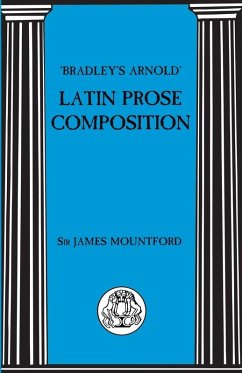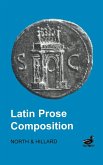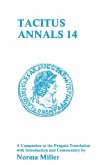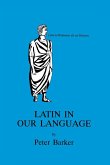- Broschiertes Buch
- Merkliste
- Auf die Merkliste
- Bewerten Bewerten
- Teilen
- Produkt teilen
- Produkterinnerung
- Produkterinnerung
This frequently reprinted volume is the 'sine qua non' for all whowould attempt to write faultless classical Latin Prose. It is impressively detailed in explaining syntactical nuances, in its exemplification andin the range of its exercise. Bradley's Arnold remains an essentialsource.
Andere Kunden interessierten sich auch für
![Latin Prose Composition Latin Prose Composition]() A.E. HillardLatin Prose Composition36,99 €
A.E. HillardLatin Prose Composition36,99 €![Key to Advanced Latin Key to Advanced Latin]() James MorwoodKey to Advanced Latin26,99 €
James MorwoodKey to Advanced Latin26,99 €![Via Plana Via Plana]() P. Ruth Taylor-BriggsVia Plana28,99 €
P. Ruth Taylor-BriggsVia Plana28,99 €![Latin Unseen Translation Latin Unseen Translation]() Roy HydeLatin Unseen Translation28,99 €
Roy HydeLatin Unseen Translation28,99 €![Selections from Virgil's Aeneid Books 1-6 Selections from Virgil's Aeneid Books 1-6]() Ashley Carter (UK Independent Scholar)Selections from Virgil's Aeneid Books 1-625,99 €
Ashley Carter (UK Independent Scholar)Selections from Virgil's Aeneid Books 1-625,99 €![Tacitus Tacitus]() Cornelius TacitusTacitus30,99 €
Cornelius TacitusTacitus30,99 €![Latin in Our Language Latin in Our Language]() Peter BarkerLatin in Our Language26,99 €
Peter BarkerLatin in Our Language26,99 €-
-
-
This frequently reprinted volume is the 'sine qua non' for all whowould attempt to write faultless classical Latin Prose. It is impressively detailed in explaining syntactical nuances, in its exemplification andin the range of its exercise. Bradley's Arnold remains an essentialsource.
Produktdetails
- Produktdetails
- Verlag: Bloomsbury Publishing PLC
- Seitenzahl: 456
- Erscheinungstermin: 1. April 2013
- Englisch
- Abmessung: 216mm x 140mm x 24mm
- Gewicht: 566g
- ISBN-13: 9780862921507
- ISBN-10: 0862921503
- Artikelnr.: 22263829
- Herstellerkennzeichnung
- Libri GmbH
- Europaallee 1
- 36244 Bad Hersfeld
- gpsr@libri.de
- Verlag: Bloomsbury Publishing PLC
- Seitenzahl: 456
- Erscheinungstermin: 1. April 2013
- Englisch
- Abmessung: 216mm x 140mm x 24mm
- Gewicht: 566g
- ISBN-13: 9780862921507
- ISBN-10: 0862921503
- Artikelnr.: 22263829
- Herstellerkennzeichnung
- Libri GmbH
- Europaallee 1
- 36244 Bad Hersfeld
- gpsr@libri.de
Sir James Mountford was Professor of Latin at the University of Liverpool, UK.
Introduction The Parts of Speech
Analysis of the Sentence
Order of Words and Clauses
Exercises
1. Elementary Rules
II.III Meaning of Words and Phrases
IV. Agreement of Subject and Verb
V. VI. Accusative with Infinitive, Oratio Obliqua
VII. Nominative with Infinitive
vm. Adjective-Agreement, use as nouns etc
IX. Adjectives and Adverbs
X. XI. The Relative
xn. Correlatives
XIII. The Infinitive as a noun
XIV. Final clauses - sequence of tenese
XV. consecutive clauses
XVI. Ut, Ne, introducing a noun Clause
XVII. Quominus, Quin - verbs of fearing
xVIII. Commands and Prohibitions
XIX. Remarks on Moods - subjunctive used Independently
XX. Interrogative Sentences Direot
XXI. XXII. Interrogative Sentences Dependent or indirect
XXIIL tenses of the indicative
XXIV. How to translate can, could, may, might, shall, must etc.
XXV. Remarks on the Cases-the Nominative.
XXVI. Apposition
XXVU. XXVIII. The Accusative
XXIX.-XXXII. The Dative
XXXIII.-XXXV. The Ablative
XXXVI.-XL. The Genitive
XLI. Place, Space
XLII. Expressions of Time
XLIII. Preposition-General Remarks ; Prepositions with
Accusative
XLIV. Prepositions with Ablative
XLV. Pronouns, personal and Demonstrative
XL VI. Pronouns, reflexive and Emphatic
XL VII. Pronouns, Indefinite
XLVHI. A and B. Pronouns, idem, alius etc
XLIX. L. Gerund and Gerundive
LL The Supines
LIL Participles
LIIL The Ablative Absolute
LIV. Temporal Clauses-General Rules, cum
LV. Temporal Clauses Dum, donec, priusquam, etc.
LVI. oratio obliqua
LVII.-LIX. Conditional Clauses
LX Concessive Clauses
LXI. Causal and Explanatory Clauses
LXU. Comparative Clauses
LXIII. Qui clauses - final and consecutive
LXIV. Qui clauses: causal and concessive
LXV. Reported Speeches in Oratio Obliqua
LXVI. Numerals
LXVIL The Roman Calendar
Appendix: continuous prose composition
Preliminary Hints
Passages for Translation
General vocabulary
Index of subjects
Latin index
Analysis of the Sentence
Order of Words and Clauses
Exercises
1. Elementary Rules
II.III Meaning of Words and Phrases
IV. Agreement of Subject and Verb
V. VI. Accusative with Infinitive, Oratio Obliqua
VII. Nominative with Infinitive
vm. Adjective-Agreement, use as nouns etc
IX. Adjectives and Adverbs
X. XI. The Relative
xn. Correlatives
XIII. The Infinitive as a noun
XIV. Final clauses - sequence of tenese
XV. consecutive clauses
XVI. Ut, Ne, introducing a noun Clause
XVII. Quominus, Quin - verbs of fearing
xVIII. Commands and Prohibitions
XIX. Remarks on Moods - subjunctive used Independently
XX. Interrogative Sentences Direot
XXI. XXII. Interrogative Sentences Dependent or indirect
XXIIL tenses of the indicative
XXIV. How to translate can, could, may, might, shall, must etc.
XXV. Remarks on the Cases-the Nominative.
XXVI. Apposition
XXVU. XXVIII. The Accusative
XXIX.-XXXII. The Dative
XXXIII.-XXXV. The Ablative
XXXVI.-XL. The Genitive
XLI. Place, Space
XLII. Expressions of Time
XLIII. Preposition-General Remarks ; Prepositions with
Accusative
XLIV. Prepositions with Ablative
XLV. Pronouns, personal and Demonstrative
XL VI. Pronouns, reflexive and Emphatic
XL VII. Pronouns, Indefinite
XLVHI. A and B. Pronouns, idem, alius etc
XLIX. L. Gerund and Gerundive
LL The Supines
LIL Participles
LIIL The Ablative Absolute
LIV. Temporal Clauses-General Rules, cum
LV. Temporal Clauses Dum, donec, priusquam, etc.
LVI. oratio obliqua
LVII.-LIX. Conditional Clauses
LX Concessive Clauses
LXI. Causal and Explanatory Clauses
LXU. Comparative Clauses
LXIII. Qui clauses - final and consecutive
LXIV. Qui clauses: causal and concessive
LXV. Reported Speeches in Oratio Obliqua
LXVI. Numerals
LXVIL The Roman Calendar
Appendix: continuous prose composition
Preliminary Hints
Passages for Translation
General vocabulary
Index of subjects
Latin index
Introduction The Parts of Speech
Analysis of the Sentence
Order of Words and Clauses
Exercises
1. Elementary Rules
II.III Meaning of Words and Phrases
IV. Agreement of Subject and Verb
V. VI. Accusative with Infinitive, Oratio Obliqua
VII. Nominative with Infinitive
vm. Adjective-Agreement, use as nouns etc
IX. Adjectives and Adverbs
X. XI. The Relative
xn. Correlatives
XIII. The Infinitive as a noun
XIV. Final clauses - sequence of tenese
XV. consecutive clauses
XVI. Ut, Ne, introducing a noun Clause
XVII. Quominus, Quin - verbs of fearing
xVIII. Commands and Prohibitions
XIX. Remarks on Moods - subjunctive used Independently
XX. Interrogative Sentences Direot
XXI. XXII. Interrogative Sentences Dependent or indirect
XXIIL tenses of the indicative
XXIV. How to translate can, could, may, might, shall, must etc.
XXV. Remarks on the Cases-the Nominative.
XXVI. Apposition
XXVU. XXVIII. The Accusative
XXIX.-XXXII. The Dative
XXXIII.-XXXV. The Ablative
XXXVI.-XL. The Genitive
XLI. Place, Space
XLII. Expressions of Time
XLIII. Preposition-General Remarks ; Prepositions with
Accusative
XLIV. Prepositions with Ablative
XLV. Pronouns, personal and Demonstrative
XL VI. Pronouns, reflexive and Emphatic
XL VII. Pronouns, Indefinite
XLVHI. A and B. Pronouns, idem, alius etc
XLIX. L. Gerund and Gerundive
LL The Supines
LIL Participles
LIIL The Ablative Absolute
LIV. Temporal Clauses-General Rules, cum
LV. Temporal Clauses Dum, donec, priusquam, etc.
LVI. oratio obliqua
LVII.-LIX. Conditional Clauses
LX Concessive Clauses
LXI. Causal and Explanatory Clauses
LXU. Comparative Clauses
LXIII. Qui clauses - final and consecutive
LXIV. Qui clauses: causal and concessive
LXV. Reported Speeches in Oratio Obliqua
LXVI. Numerals
LXVIL The Roman Calendar
Appendix: continuous prose composition
Preliminary Hints
Passages for Translation
General vocabulary
Index of subjects
Latin index
Analysis of the Sentence
Order of Words and Clauses
Exercises
1. Elementary Rules
II.III Meaning of Words and Phrases
IV. Agreement of Subject and Verb
V. VI. Accusative with Infinitive, Oratio Obliqua
VII. Nominative with Infinitive
vm. Adjective-Agreement, use as nouns etc
IX. Adjectives and Adverbs
X. XI. The Relative
xn. Correlatives
XIII. The Infinitive as a noun
XIV. Final clauses - sequence of tenese
XV. consecutive clauses
XVI. Ut, Ne, introducing a noun Clause
XVII. Quominus, Quin - verbs of fearing
xVIII. Commands and Prohibitions
XIX. Remarks on Moods - subjunctive used Independently
XX. Interrogative Sentences Direot
XXI. XXII. Interrogative Sentences Dependent or indirect
XXIIL tenses of the indicative
XXIV. How to translate can, could, may, might, shall, must etc.
XXV. Remarks on the Cases-the Nominative.
XXVI. Apposition
XXVU. XXVIII. The Accusative
XXIX.-XXXII. The Dative
XXXIII.-XXXV. The Ablative
XXXVI.-XL. The Genitive
XLI. Place, Space
XLII. Expressions of Time
XLIII. Preposition-General Remarks ; Prepositions with
Accusative
XLIV. Prepositions with Ablative
XLV. Pronouns, personal and Demonstrative
XL VI. Pronouns, reflexive and Emphatic
XL VII. Pronouns, Indefinite
XLVHI. A and B. Pronouns, idem, alius etc
XLIX. L. Gerund and Gerundive
LL The Supines
LIL Participles
LIIL The Ablative Absolute
LIV. Temporal Clauses-General Rules, cum
LV. Temporal Clauses Dum, donec, priusquam, etc.
LVI. oratio obliqua
LVII.-LIX. Conditional Clauses
LX Concessive Clauses
LXI. Causal and Explanatory Clauses
LXU. Comparative Clauses
LXIII. Qui clauses - final and consecutive
LXIV. Qui clauses: causal and concessive
LXV. Reported Speeches in Oratio Obliqua
LXVI. Numerals
LXVIL The Roman Calendar
Appendix: continuous prose composition
Preliminary Hints
Passages for Translation
General vocabulary
Index of subjects
Latin index









